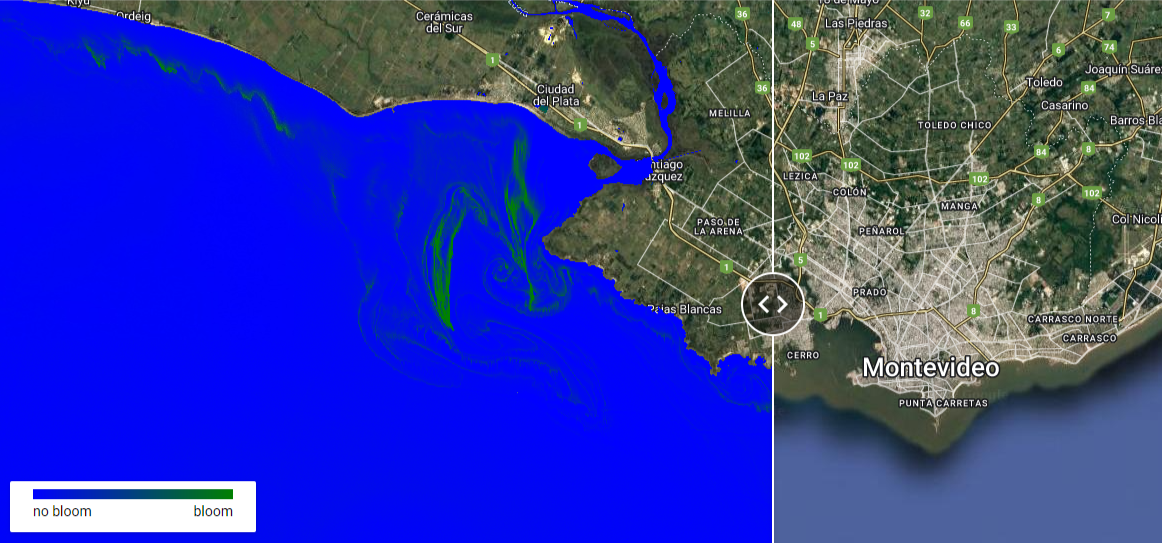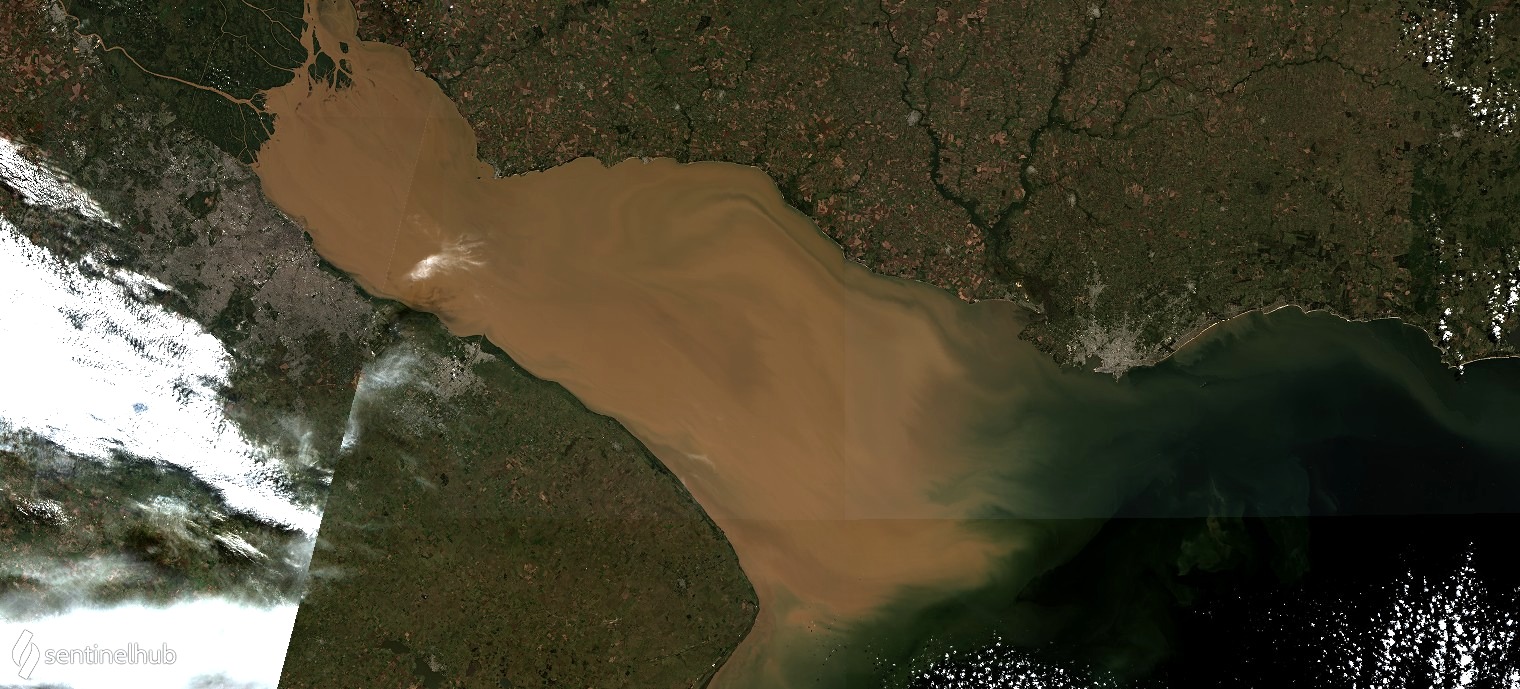Early Adopter

Universidad de la República, Uruguay
Applied Research Topic
Potential Applications ► Suspended sediment characterization; Cyanobacteria detection & monitoring web-application tool
Description
Located between Argentina and Uruguay, the large Río de la Plata estuary offers multiple ecosystem services of great ecological, social, and economic relevance, including transportation, fisheries, and tourism. The estuary is fed by the contribution of large South American floodplain rivers, determining an optically complex, sediment-rich water system. Sediment dynamics are of both economic and environmental importance, due to their sedimentation in navigational channels, and their influence on ecosystem dynamics. With a watershed that covers five South American countries, the estuary is subject to multiple anthropic pressures. The intensification of eutrophication in the past few decades had led to more frequent large scale cyanobacterial blooms in both its northern and southern coasts, representing a health threat. To improve the management of this important water resource, there is a clear need to incorporate sound monitoring tools. The use of hyperspectral satellite imagery is a great opportunity for near-real time synoptic monitoring of water quality parameters that cannot be well detected with current multispectral satellite, and as input to improve numerical and statistical models of relevant estuarine processes and dynamics.
The objectives of this Early Adopters project are: (1) to characterize suspended sediments from hyperspectral PACE OCI data; and (2) to improve detection and quantification of cyanobacteria, using hyperspectral remote sensing reflectance (Rrs). Using in-situ hyperspectral radiometric measurements and simulated PACE OCI datasets, we propose to: (a) estimate particulate matter inherent optical properties (IOPs) and explore their relationship to particle size distribution; and (b) detect and quantify cyanobacteria considering the absorption peaks of the pigments, chlorophyll-a, and phycocyanin. Output from this Early Adopter project will be incorporated into The National Environmental Observatory, an environmental information platform, which includes the visualization of processed satellite images in near real-time, aimed at monitoring algal blooms within reservoirs, lagoons, and the Río de la Plata Estuary.
Significance
The availability of spatial and temporal data of suspended sediments size across the estuary is a valuable resource to improve hydro-sedimentological models of the Río de la Plata, which are a useful management tool for agencies in charge of maintaining the navigation and transportation within the estuary. Early detection of potential harmful cyanobacteria at a large geographical scale is a challenge for a complex turbid and highly dynamic ecosystem as Río de la Plata. The intensification of eutrophication in the past few decades had led to more frequent large scale cyanobacterial blooms in both its northern and southern coasts, posing a significant health risk. Output of this Early Adopter project can be used as an indicator of risk conditions of noxious cyanobacteria, which can help local authorities better prepare for sanitary alerts in recreational beaches. The occurrence and abundance of cyanobacterial blooms can be used an indicator of the estuary health. This can help inform decision-making and management strategies, and improve understanding of climate change impacts, particularly those related to changes in rainfall patterns in the Río de la Plata watershed.Why PACE
Our preliminary research suggests that hyperspectral Rrs in the red to near (NIR) spectral region of PACE OCI can be used to determine particulate matter backscattering in the Río de la Plata turbid waters, which could be related to particle size distribution. Furthermore, existing work suggests that particle size distribution can be estimated from hyperspectral Rrs in the 560-630 nm range for river suspended sediments, when colored dissolved organic matter (CDOM) and chlorophyll-a concentration are known. Cyanobacterial pigments, chlorophyll-a and phycocyanin (marker phycobilin for freshwater and coastal cyanobacterial blooms), have narrow band spectral features that can be observed in our in-situ radiometric measurements. Moreover, recent research has found that the use of hyperspectral Rrs can improve chlorophyll-a retrieval in the Río de la Plata.End User(s)
- National Directorate for Quality and Environmental Assessment, Ministry of the Environment- Uruguay
- Río de la Plata Managing Agency (CARP) - Uruguay and Argentina
- Ministry of Livestock, Agriculture and Fisheries (MGAP)- Uruguay
- Department of Environmental Development, Municipality of Montevideo
- Interdisciplinary Department for Coastal and Marine Studies, Eastern Regional University Center, University of the Republic, Uruguay
- Numerical modeling group, IMFIA, School of Engineering, University of the Republic, Uruguay
SAT Partner(s)
Mike Twardowski, Dave Siegel, and Nima PahlevanPublications
Aubriot, L., Zabaleta, B., Bordet, F., Sienra, D., Risso, J., Achkar, M., & Somma, A. (2020). Assessing the origin of a massive cyanobacterial bloom in the Rio de la Plata (2019): Towards an early warning system. Water Research, 181, 115944. https://doi.org/10.1016/j.watres.2020.115944
Dogliotti, A. I., Gossn, J. I., Gonzalez, C., Yema, L., Sanchez, M. L., O'Farrell, I. (2021). Evaluation of multi- and hyper- spectral chl-a algorithms in the Rio de la Plata turbid waters during a cyanobacteria bloom. In 2021 IEEE International Geoscience and Remote Sensing Symposium IGARSS (p. 7442-7445). Brussels, Belgium: IEEE. 10.1109/IGARSS47720.2021.9553148
Haakonsson, S., Rodriguez, M. A., Carballoa, C., Perez, M. C., Arocena, R., & Bonilla, S. (2020). Predicting cyanobacterial biovolume from water temperature and conductivity using a bayesian compound Poisson-Gamma model. Water Research, 176, 115710. DOI: https://doi.org/10.1016/j.watres.2020.115710
Maciel, F. P., Santoro, P. E., & Pedocchi, F. (2021). Spatio-temporal dynamics of the Rio de la Plata turbidity front; combining remote sensing with in-situ measurements and numerical modeling. Continental Shelf Research, 213, 104301. https://doi.org/10.1016/j.csr.2020.104301
Zhang, Y., Huang, Z., Chen, C., He, Y., & Jiang, T. (2015). Particle size distribution of river-suspended sediments determined by in situ measured remote-sensing reflectance. Applied Optics, 54(20), 6367. https://doi.org/10.1364/ao.54.006367




